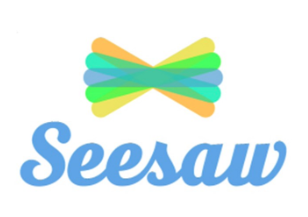
Presenting Patterning with SeeSaw

Overview
Seesaw is a web-based and application platform where students can post pictures from the classroom, annotate, speak their mind, and create electronic portfolios that connect school and home. Parents are able to see student work as soon as it is posted.
In this activity, students will solve a math problem on patterns and tangrams and explain their thinking using SeeSaw.
Learning Objectives
Students will:
- Be able to explain their thought process of creating a basic pattern.
- Be able to post their explanation to SeeSaw.
Vocabulary
Vocabulary Words:
-
Tangram: A tangram is a wood or plastic shape used for learning.
-
AB Pattern: An AB pattern repeats itself every two shapes in a sequence.
-
ABC Pattern: An ABC pattern repeats itself every three shapes in a sequence.
-
AABB Pattern: An AABB pattern repeats two shapes at a time in a sequence.
Pre-planning
To prepare for this lesson:
-
Before the lesson, teachers must set up SeeSaw accounts for their classes and invite parents to join.
-
Please view the TEACHER video on using SeeSaw in the classroom.
-
-
Students should also know the basic features of SeeSaw.
-
Please view the following videos to decide how your students will access SeeSaw. Students can access it with email, a class code or a QR code.
-
-
Here is a student video on how to use SeeSaw.
-
The SeeSaw app needs to be downloaded on student devices or bookmarked on computers.
-
Teachers will need to have Tangrams available to students.
-
Preview the video The Patterns Practice Song and decide if you want to show it or not to your students.
Note: SeeSaw has many other tutorials on their website and Help Center.
Accommodations
See the Accommodations Page and Charts on the 21things4students website in the Teacher Resources.
Steps
Directions for this activity:
-
Teach students about patterns.
-
Explain to students the three types of patterns with tangrams and show examples:
-
AB Pattern- A pattern that repeats itself every two shapes in a sequence.
-
ABC Pattern- A pattern that repeats itself every three shapes in a sequence.
-
AABB Pattern- A pattern that repeats two shapes at a time in a sequence.
-
-
As you show each pattern, ask students to help decide what comes next, just like the song.
-
Use A, B, and C to label the patterns after you and your students have completed each sequence. Students will be asked to do this in their independent work.
-
Independent Work: Students take what they have learned about patterns and use Tangrams to demonstrate the three types of patterns. They should end up with all 3 patterns represented by shapes on their desk at once.
-
Once they have all three patterns on their desk, they will add a photo of their work to SeeSaw.
-
Students open the SeeSaw app and press the “+” sign, then select the camera icon to take a photo.
-
Next, students select the draw tool to label their pattern.
-
After labeling their patterns, students tap the microphone and explain their patterns.
-
When finished, students select the green check to add it to their journal.
-
Here is a photo of the steps to add and explain a photo in SeeSaw:

Assessment Options
Different options for assessing the students:
- Observations
- Check for understanding
- Teachers can see what students have posted to their journal from the Teacher side of SeeSaw. They are able to leave feedback for students and intervene with any students who do not get the pattern concept.
MITECS Competencies & ISTE Standards
MITECS: Michigan adopted the "ISTE Standards for Students" called MITECS (Michigan Integrated Technology Competencies for Students) in 2018.
Computational Thinker
5c. Students break problems into component parts, extract key information, and develop descriptive models to understand complex systems or facilitate problem-solving.
Devices and Resources
SeeSaw works on all devices, but works best on devices with a camera.
Websites:
Get Students Started on Seesaw: Sign in with a code
Get Students Started on Seesaw: Sign in with email
Patterns Practice Song | Scratch Garden
SeeSaw
Seesaw Tutorial For Teachers- Updated 2022
What is Seesaw? Introduction For Students
CONTENT AREA RESOURCES
Math
Students use patterning in math and algebraic thinking. Students individually being able to explain how they created patterns shows their depth of knowledge about sequencing, in turn helping other sequences like counting and numbers.
CREDITS
This task card was created by Lacey Khon, KRESA, November 2018. Updated October 2023.


